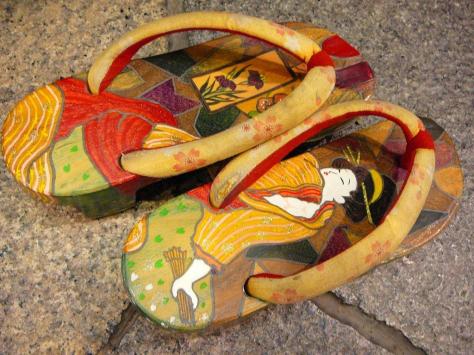At last I had the opportunity to visit and witness the power of a Japanese lady in Shizuoka Prefecture!
Yukiko Mizutori had not thought of succeeding her father, Masashi Mizutori, the 3rd generation owner of Mizutori Company founded in 1937 in Shizuoka City and instead opted to become a beautician 10 years ago.
Jonathan holding the main sole (“dai”) of a geta in its original form cut out of high quality hinoki/Japanese cypress.
But 4 years ago, having worked away from home for 7 years and getting married to Jonathan Barnabe from Quebec, she had to take a dudden turnin her life when her father, due to declining health, became increasingly worried about his business.
Beautiful range of sandal straps (“hanao”) from which customers can choose.
Having no sons, but three daughters, Yukiko being the second one, it would have been nigh impossible to find a suitable successor when she decided to ask her father to let her take care of Mizutori Company. He accepted and now only participates as a an overseer and exhibition manager.
On the other hand Yukiko had to study very hard and fast to succeed him.
Lady staff working on the sole of a geta.
But in spite of the enormity of her decision to take over acompany in male-dominated industry, she did have some advantages:
First, as a lady she would be free to implement new ideas and thinking into the craft.
Second, her husband is a former engineer nad now that he has acquired sufficient abilty in the Japanese language he can contribute much needed unique ideas to develop the business.
Third, instead of thinking solely of competition, she knew that collaboration would be far more beneficial and outsourced the making of geta with more than 12 local companies to provide design ideas, materials and work togeteher for combined products.
Fourth, and maybe more importantly, she uses, as much as possible, Japanese material form nearbymountains and forests.
When she needs exoctic wood her husband travel to Vietnam, Indonesia and other countries where his foreign language ability comes in handy.
Making geta/sandals involved many materials which have to be stored permanently!
Her company presently counts 15 staff and all participate, young and not so young, to the whole concpet of the company, even modelling for their pamhlets and brochures!
Not only her company supports local workers by using made-in-Shizuoka products whenever possible but also by hiring residents in the neighborhood.
Some work is done with traditional machiney.
But highly specialsed craft needs the hands and skills of veterans!
But young power is also definitely needed!
Without mentioning the need for a professional office team!
And orders are piling up!
Prices for Mizutori’s geta range from ¥6,800 to ¥18,000, but those painted with urushi lacquer cost as much as ¥200,000, and the award-winning made-to-order product requires two months until delivery.
Geta can be made with flat soles in a modern style but also with two ha/stilts for more tradiyonal footwear.
Geta may look unwieldy at first to a Westerner, but the fit and breathability are such that they are as easy to wear as a rubber beach sandal.
Mizutori Company provides sandals up to 32 size!
Geta are designed both for ladies and gentlemen and of course for children.
As for ladies’ footwear height can be designed according to the customer’s priorities and preferences!
The great news is that Mizutori Company is planning to accept and design visits for foreign visitors who will be able to make their own sandals on site!
They would certainly make for a great and unique souvenir gift back home!
The other good news are that Mizutori Company will soon open an otlet shop in the middle of Shizuoka City, on Aoba Street (Aoi Ward) in the middle of the of an area replet with great shops, izakayas and restaurants. But this is for another article!
Mizutori Company
Address: 420-0876 Shizuoka City, Aoi Ku, Heiwa, 1-16-22
Tel.: 054-271-6787 (English & French possible)
Fax: 054-272-1302
E-Mail: info@mizutori.co.jp
Homepage: http://www.geta.co.jp
Web Shop: http://www.geta-shop.jp
RECOMMENDED RELATED WEBSITES
So Good Sushi Restaurant in Nice France
Navigating Nagoya by Paige, Shop with Intent by Debbie, BULA KANA in Fiji, Kraemer’s Culinary blog by Frank Kraemer in New York,Tokyo Food File by Robbie Swinnerton, Green Tea Club by Satoshi Nihonyanagi in Shizuoka!, Mind Some by Tina in Taiwan, Le Manger by Camille Oger (French), The Indian Tourist, Masala Herb by Helene Dsouza in Goa, India, Mummy I Can Cook! by Shu Han in London, Pie
rre.Cuisine, Francescannotwrite, My White Kitchen, Foodhoe, Chucks Eats, Things that Fizz & Stuff, Five Euro Food by Charles,Red Shallot Kitchen by Priscilla,With a Glass, Nami | Just One Cookbook, Peach Farm Studio, Clumsyfingers by Xethia, PepperBento, Hapabento, Kitchen Cow, Lunch In A Box, Susan at Arkonlite, Vegan Lunch Box; Tokyo Tom Baker, Daily Food Porn/Osaka, Only Nature Food Porn, Happy Little Bento, J-Mama’s Kitchen, Cook, Eat, Play, Repeat, Bento Lunch Blog (German), Adventures In Bento, Anna The Red’s Bento Factory, Ohayo Bento,
Must-see tasting websites:
-Sake: Ichi For The Michi by Rebekah Wilson-Lye in Tokyo, Tokyo Through The Drinking Glass, Tokyo Foodcast, Urban Sake, Sake World
-Wine: Palate To Pen, Warren Bobrow, Cellar Tours, Ancient Fire Wines Blog
-Beer: Another Pint, Please!, Beering In Good Mind: All about Craft Beer in Kansai by Nevitt Reagan!
ABRACADABREW, Magical Craftbeer from Japan
-Whisky: Nonjatta: All about whisky in Japan by Stefan Van Eycken
-Japanese Pottery to enjoy your favourite drinks: Yellin Yakimono Gallery
Non gastronomy must-see sites by Shizuoka Residents
HIGHOCTANE/HAIOKU by Nick Itoh in Shizuoka City






















